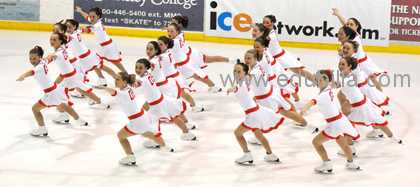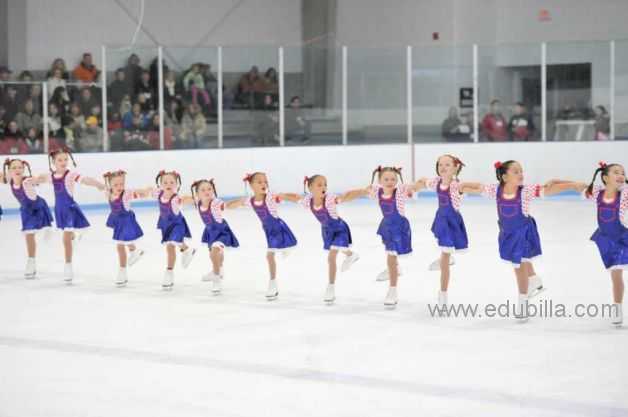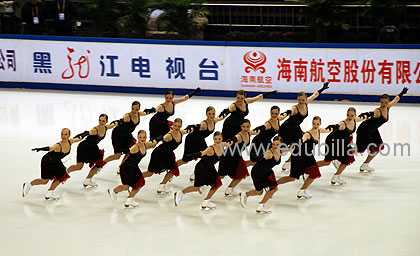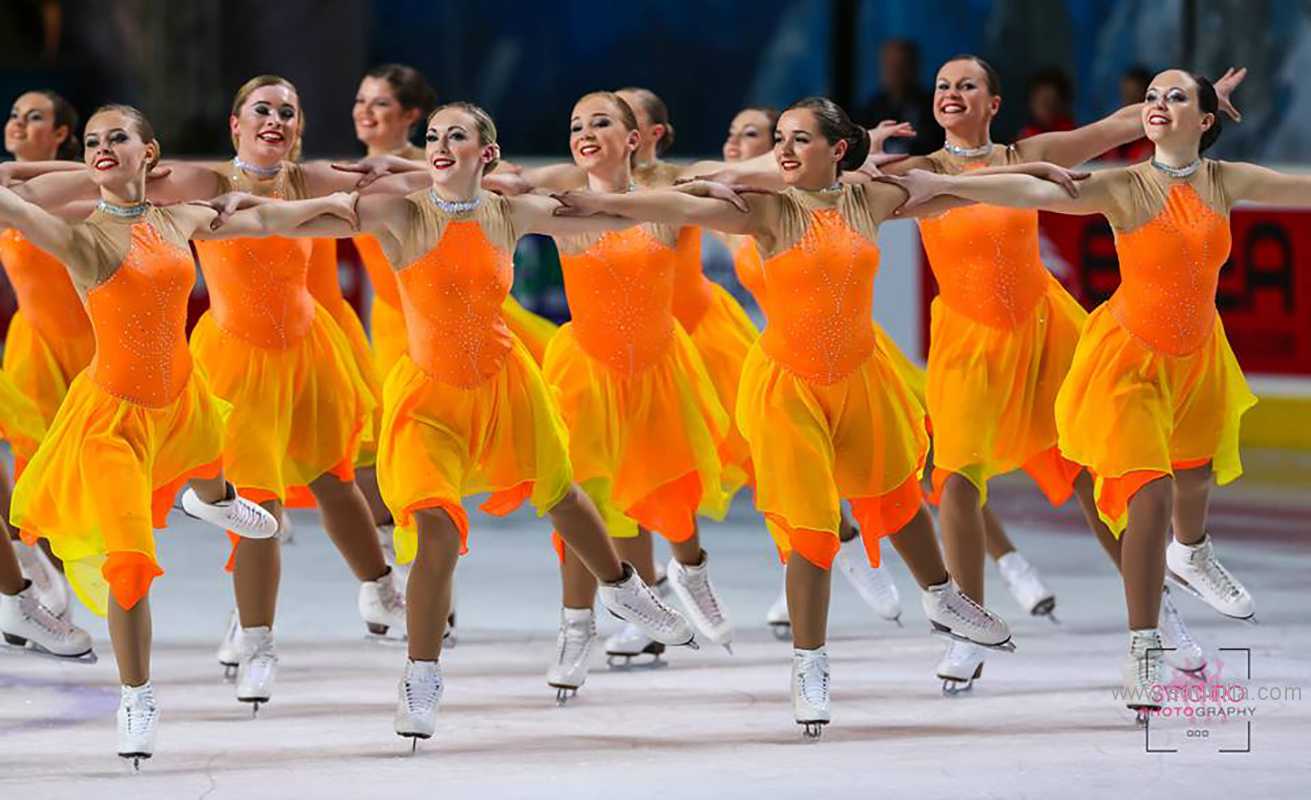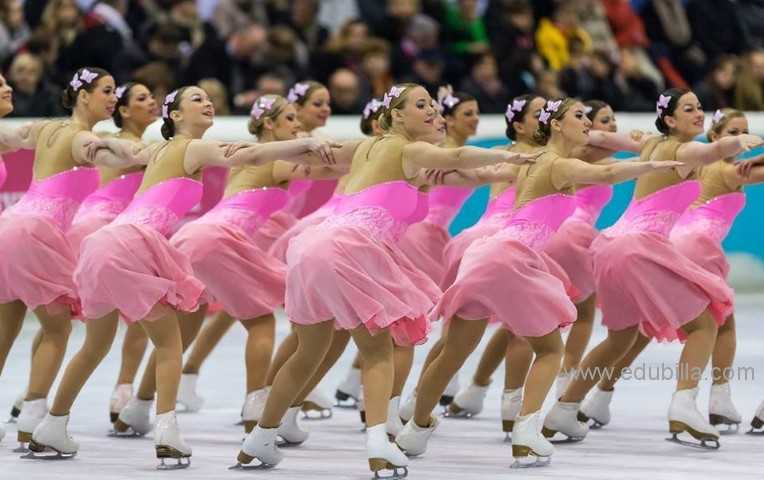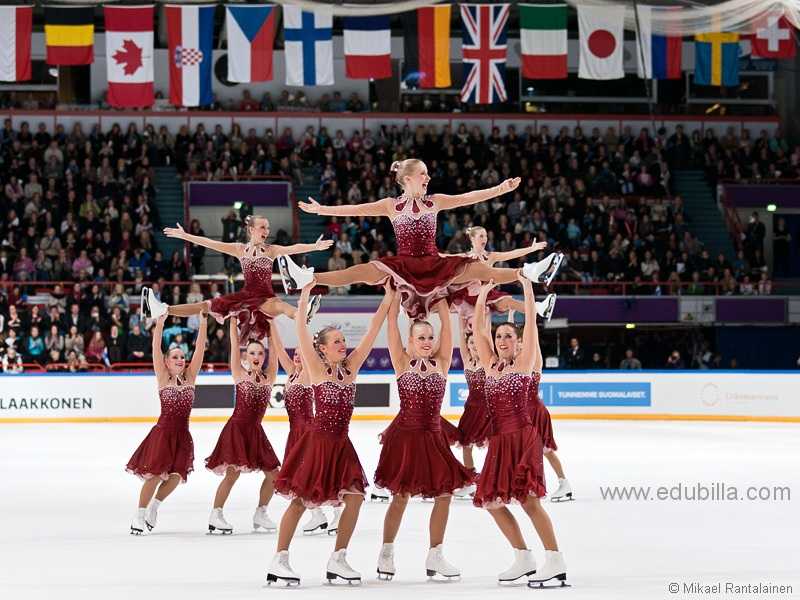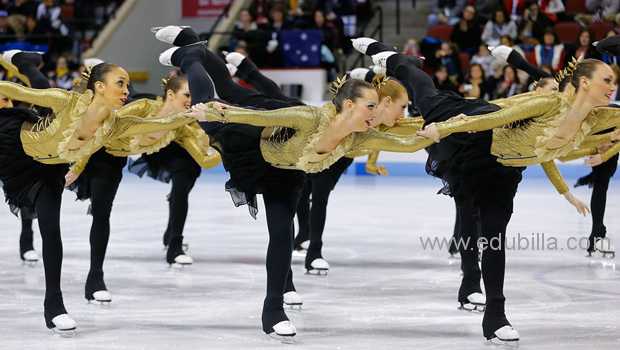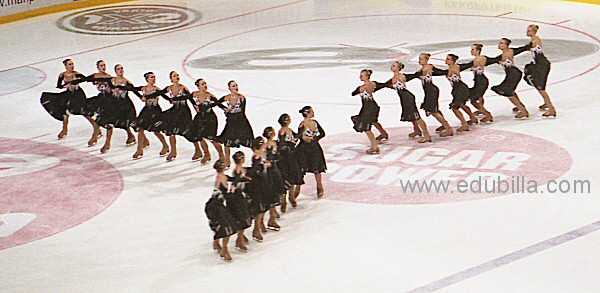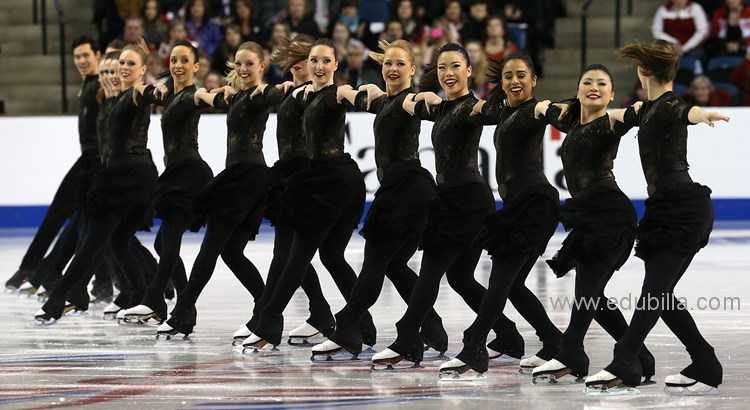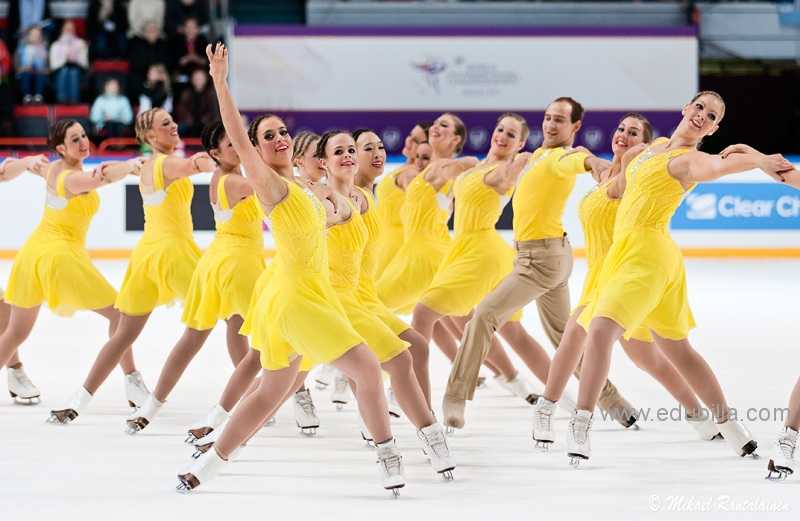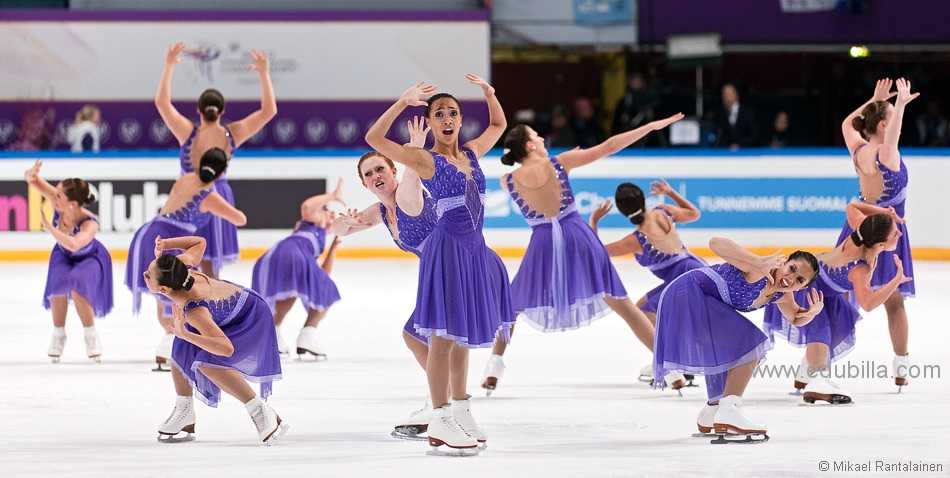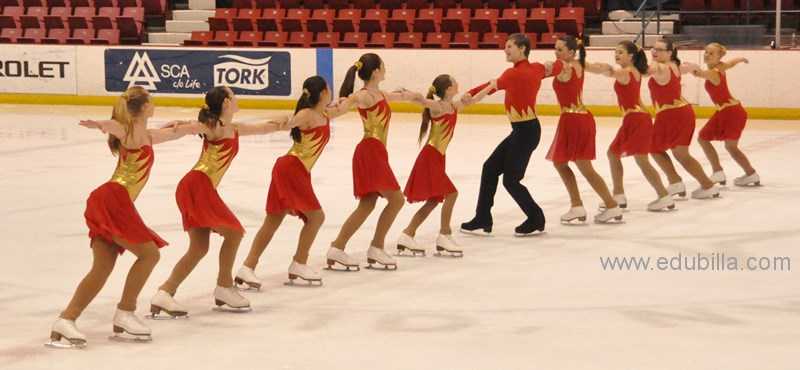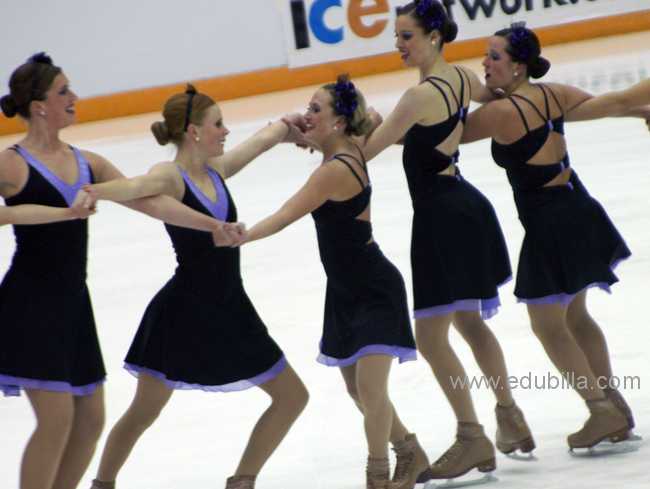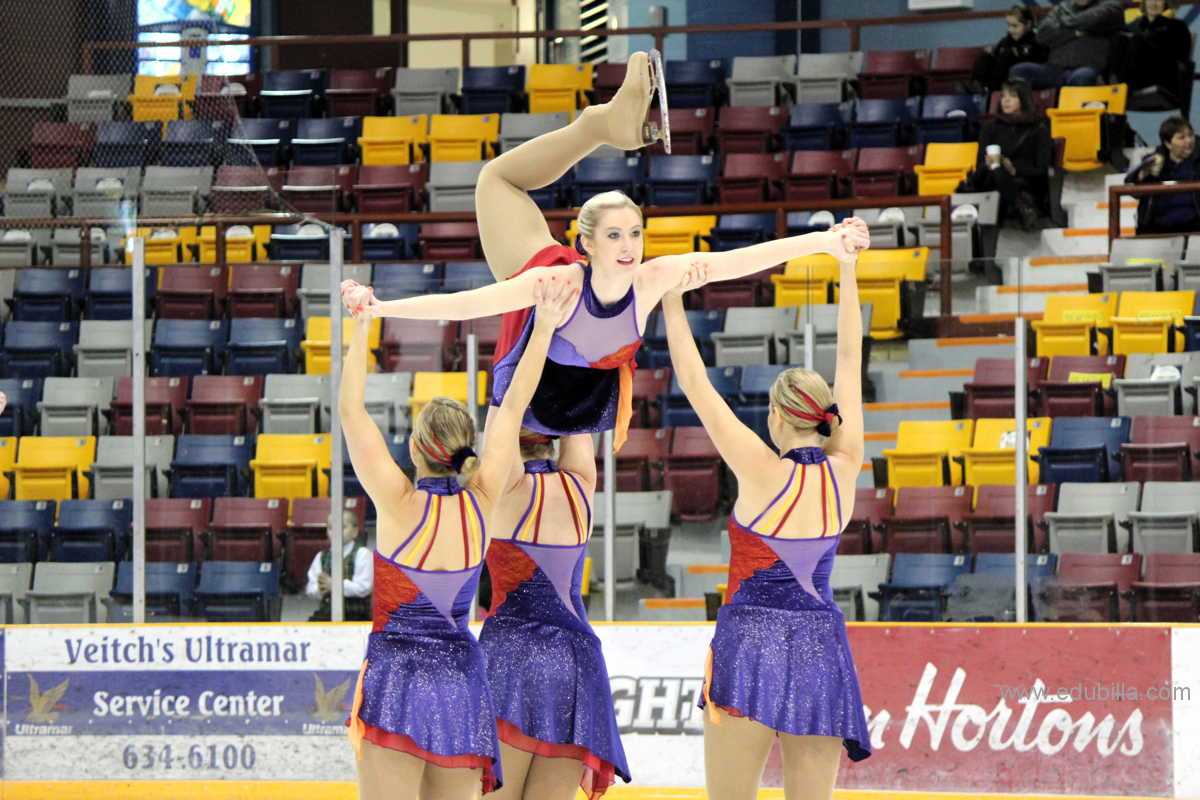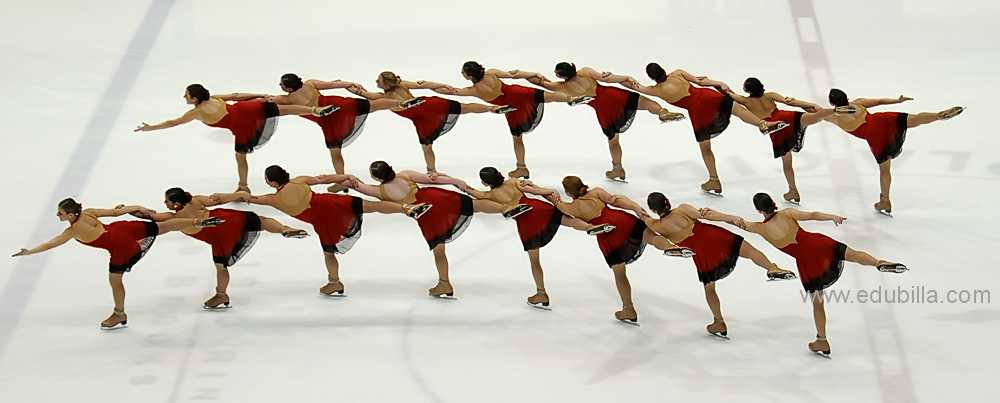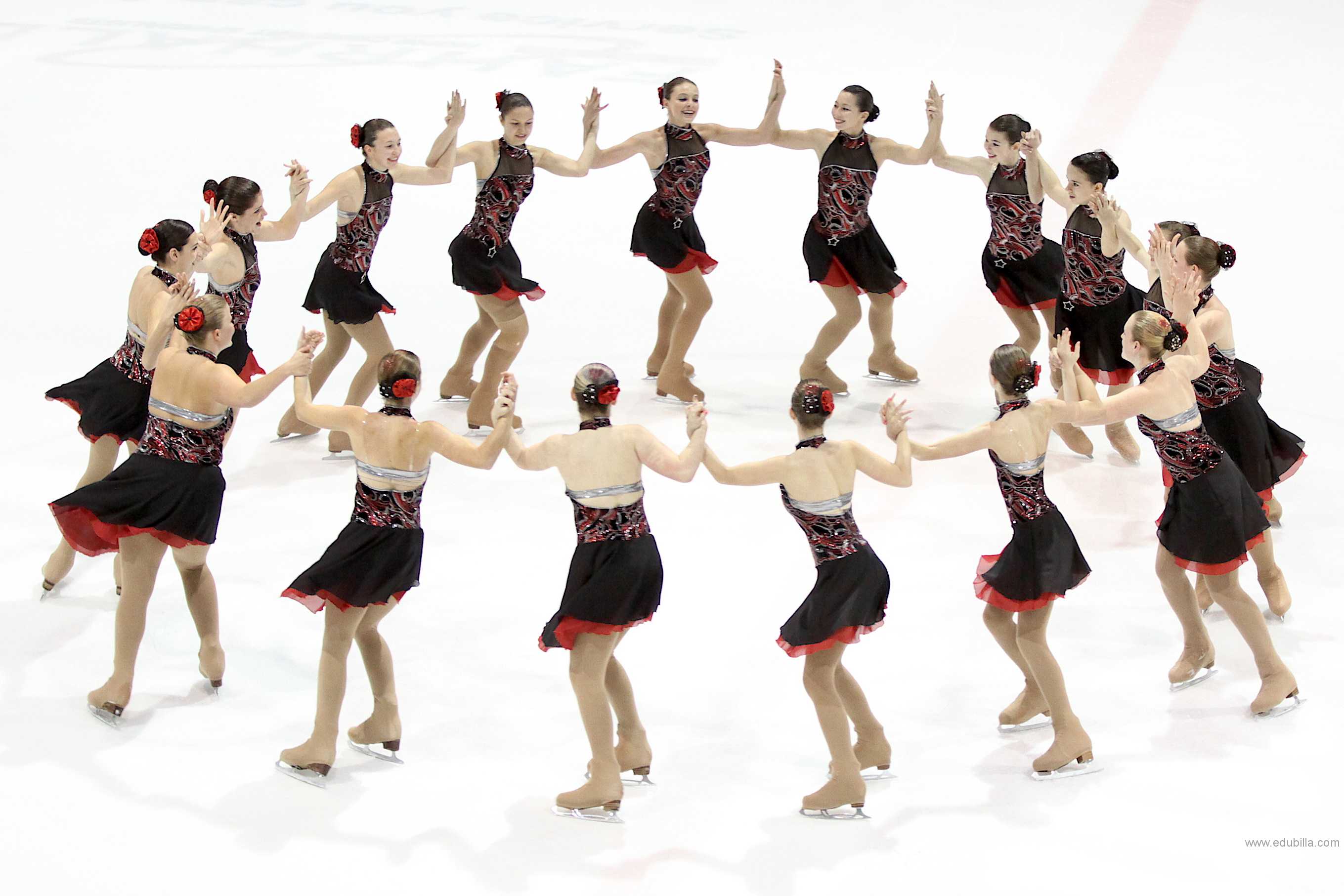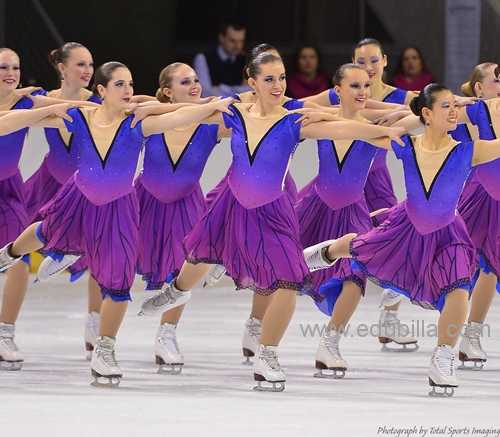
Overview Of Synchronized skating
Synchronized skating is a popular discipline both within U.S. Figure Skating and around the world. U.S. Figure Skating held the first U.S. Synchronized Skating Championships in 1984 and also hosted the first World Synchronized Skating Championships in 2000. There are approximately 525 synchronized teams registered with U.S. Figure Skating, and nearly 5,000 athletes participate annually in the synchronized skating sectional championships.
Synchronized skating is a team sport in which 8-20 skaters perform a program together. It uses the same judging system as singles, pairs and dance and is characterized by teamwork, speed, intricate formations and challenging step sequences. As with the other disciplines, all teams perform a free skate with required well-balanced program elements. In addition, teams at the junior and senior level perform a short program consisting of required elements.
Elements in synchronized skating include blocks, circles, wheels, lines, intersections, moves in the field, the creative element, the combined element, no-hold step sequences, spins and pairs moves. The variety and difficulty of elements require that each team member is a highly skilled individual skater. The typical senior-level athlete has passed a senior or gold test in at least two disciplines.
Game Rules
Beginner 1, 2 or 3: A team of 8-16 skaters. No skater may have passed higher than preliminary in any discipline, and the majority of the team must be no test. Please see the beginner page for specific information related to each beginner level.
Preliminary: A team of 8-16 skaters. Skaters must be under 12, with the majority of the team under 10.
Pre-juvenile: A team of 8-16 skaters. The majority of the team must be under 12.
Open Juvenile: A team of 8-16 skaters. All skaters must be under age 20. All skaters must have passed the pre-preliminary moves in the field test.
Juvenile: A team of 12-20 skaters. Skaters must be under 13 and have passed the preliminary moves in the field test.
Intermediate: A team of 12-20 skaters. Skaters must be under 18 and have passed the pre juvenile moves in the field test.
Novice: A team of 12-20 skaters. Skaters must be under 16, with the exception of four skaters who may be 16 or 17, and have passed the juvenile moves in the field test.
Junior: A team of 12-16 skaters. Skaters must be at least 13 years old and under 19. All skaters must have passed the intermediate moves in the field test.
Senior: A team of 16 skaters. Skaters must be at least 15 years old and have passed the novice moves in the field test.
Open Collegiate: A team of 8-16 skaters. Skaters must be enrolled in a college or degree program as full-time students.
Collegiate: A team of 12-20 skaters. Skaters must be enrolled in a college or degree program as full-time students and have passed the juvenile moves in the field test.
Open Adult: A team or 8-16 skaters. The majority of the team must be 19 years or older.
Open Masters: A team of 8-16 skaters. All skaters must be 25 years or older, with the majority of the team 30 years or older.
Masters: A team or 12-20 skaters. All skaters must be 25 years or older, with the majority of the team 30 years or older.
Adult: A team or 12-20 skaters. All skaters must be 21 years or older, with the exception that up to four skaters may be 18, 19 or 20. All skaters must have passed at least one of the following tests: preliminary moves in the field, adult bronze moves in the field, preliminary figure or preliminary dance.
Detailed Synchronized skating Rules Can Be Downloaded From Documents
Equipments Need For Synchronized skating
Synchronized skating Custom
Quad Skates
History Of Synchronized skating
Synchronized skating was called precision skating at one time.The original emphasis was for the group of skaters to keep tight formations and to march to precise rhythms. Precision teams looked a bit like drill teams or marching bands. Synchronized skating of today requires much more complicated skating than the original precision skating teams. In 1998 the name was officially changed to "Synchronized Skating."
Timeline:
Synchronized skating began nearly 50 years ago, when the first group of skaters was organized to perform at University of Michigan ice hockey games in Ann Arbor, Mich. It has since grown into a competitive discipline of skating with thousands of athletes participating all over the world.
1954-Dr. Richard Porter pioneered modern synchronized skating when he organized the first group of team skaters in Ann Arbor, Mich.
1976-The first official team skating compeition was held in Ann Arbor, Mich.
1984-The first U.S. Synchronized Team Skating Championships was held in Bowling Green, Ohio, with 38 teams participating.
1989-Sweden hosted the first international synchronized skating competition with teams from seven countries participating.
1994-The International Skating Union (ISU) officially recognized synchronized skating at the ISU Congress.
1996-The U.S. hosted the first World Synchronized Skating Challenge Cup with 17 teams from 13 countries.
2000-The ISU conducted the first World Synchronized Skating Championships, held in Minneapolis, Minn., with 21 teams from 16 countries participating. The U.S. named the first U.S. World Synchronized Skating Team comprised of 48 athletes.
2003-U.S. Figure Skating held the 20th U.S. Synchronized Team Skating Championships in Huntsville, Ala., with more than 2,200 athletes on 104 teams participating.
2007-Synchronized skating is added to the World University Games schedule. Miami University represents U.S. Figure Skating and finishes fourth.
Team USA wins its first medal at the World Synchronized Skating Championships as the Miami University Synchronized Skating Team, from Oxford, Ohio, brings home the silver.
2008-U.S. Figure Skating holds the 25th U.S. Synchronized Skating Championships, hosted by the Colonial FSC in Providence, R.I. Approximately 4,500 athletes on 288 synchronized skating teams enter their respective sectional championships in hopes of qualifying for this event.
2010-U.S. Figure Skating hosts the 2010 World Synchronized Skating Championships in Colorado Springs, Colo. The Haydenettes, from Lexington, Mass., earn the bronze medal, the second World medal won by a U.S. synchronized team.
Origin Of Synchronized skating
Synchronized skating, a large and fast growing discipline, consists of 8-20 athletes skating on the ice at one time moving as one flowing unit at high speeds. This discipline of Synchronized Skating was originally called precision skating in North America because of the emphasis on maintaining precise formations and timing of the group.
University of Michigan Wolverines hockey team:
The 'Hockettes' skated out of Ann Arbor, Michigan and entertained spectators during intermissions of the University of Michigan Wolverines hockey team. In the early days, precision skating (as it was then called) resembled a drill team routine, or a precision dance company such as The Rockettes.
First Synchronized Skating Team:
Dr. Richard Porter is given credit for forming the 'Hockettes' as the first synchronized skating team. He became known as the 'father of synchronized skating'. The 'Hockettes' skated out of Ann Arbor, Michigan and entertained spectators during the intermissions of the University of Michigan Men’s Hockey Team. In the early days, precision skating (as it was then called) resembled a drill team routine, or a precision dance company such as The Rockettes.During the 1970’s, the interest in this new sport grew and resulted other areas to form their own teams. With the passage of each season, more teams began to develop more creative and innovative routines incorporating stronger skating skills, new maneuvers with sophisticated transitions performed with greater speed, style and agility.
First Official International Competition:
Due to the enormous interest in the sport in North America, the first official international competition was held between Canadian and American teams in Michigan in March 1976. With the internationalization of the sport, it has evolved rapidly, with increasing emphasis on speed and skating skills, and "highlight" elements such as jumps, spins, and lifts that originally were not permitted in competition.
First official World Synchronized Skating Championships (WSSC):
There are international synchronized skating competitions at the Senior, Junior, and Novice levels (with Senior being the most elite). The International Skating Union held the first official World Synchronized Skating Championships (WSSC) in 2000 in Minneapolis, Minnesota, USA. The top junior teams from around the world competed from 2001 to 2012 at the ISU Junior World Challenge Cup (JWCC), held in a different location every year. The JWCC were accompanied in 2013 by the ISU World Junior Synchronized Skating Championships, to be held biannually in odd-numbered years with the JWCC in even-numbered years.Other long-running, major international events attracting elite teams at different levels include the French Cup, Spring Cup, Neuchâtel Trophy, Cup of Berlin, Zagreb Snowflakes Trophy and Prague Cup.
Governing Bodies
International Skating Union(ISU):
The International Skating Union, founded in 1892, is the exclusive international sport federation recognized by the International Olympic Committee (IOC) administering sports in the Branches of Figure Skating and Speed Skating throughout the world. (Long Track) Speed Skating and Short Track Speed Skating come under the Speed Skating Branch while Single & Pair Skating and Ice Dance and Synchronized Skating constitute the Figure Skating Branch. The ISU is composed of a number of national associations called ISU Members, who administer ISU sports at the national level and recognize that all international matters are under the sole jurisdiction and control of the ISU.

Synchronized Skating Events:
- ISU World Synchronized Skating Championships
- ISU World Junior Synchronized Skating Championships
- ISU Synchronized Skating Junior World Challenge Cup
Timeline:
1889-The first World Championships in Speed Skating were held in Amsterdam (NED) for men only
1891-The first European Championships in both Speed Skating and Figure Skating (open to men only) were held at the same time in Hamburg (GER)
1893-The first World Championships in Speed Skating (open to men only) directly under the auspices of the ISU were held in Amsterdam (NED),The European Speed Skating and Figure Skating Chamionships (for European men skaters only) were hosted together in Berlin (GER)
1896-The first World Figure Skating Championships (open to men only) were organized in St Petersburg (RUS)
1897-The first World Championships (in Speed Skating) to be held outside Europe were organized in Montreal (CAN)
1906-The first ISU Championships for Ladies Figure Skating were organized in Davos (SUI) and became World Championships in 1924
1908-The first ISU Championships for Pairs Figure Skating were held in St Petersburg (RUS) and became World Championships in 1924,Figure Skating (including events for Ladies, Men, Pairs and Special Figures) was the first winter sport to be included in the Olympic Games held in London (GBR)
1920-Figure Skating (with events for Ladies, Men and Pairs) was included in the Olympic Games held in Antwerp (BEL)
1924-Both Speed Skating and Figure Skating were included in the official program of the first Olympic Winter Games, held in Chamonix (FRA)
1930-The first World Figure Skating Championships to be held outside Europe, which included all three events together (Men, Ladies and Pairs), were held in New York City (USA)
1936-The first Speed Skating World Championships for Ladies were held in Stockholm (SWE) but would not become an Olympic competition for another twenty-four years
1950-The first international competition in ice dancing was held in London on the occasion of the World Figure Skating Championships
1952-The first World Championships in Ice Dancing were introduced held at the World Figure Skating Championships s in Paris (FRA)
1970-The first ISU Sprint Speed Skating Championships for Men and Ladies were inaugurated held in West Allis (USA) and became World Championships in 1972
1973-The first ISU Junior Speed Skating Championships were held in Assen (NED) and became World Championships in 1974
1976-Ice Dancing was included in the official program for the first time at the Winter Olympic Winter Games that were held in Innsbruck (AUT),The first ISU Junior Figure Skating Championships were held in Megève (FRA) and became World Championships in 1978
1978-The first ISU Short Track Speed Skating Championships, for Men and Ladies, were held in Solihull (GBR) and became World Championships in 1981s in 1981
1984-The first ISU Congress to be held outside Europe took place in Colorado Springs (USA),The World Cup events series in Speed Skating were inaugurated. Separate circuits were held for Men and Ladies until 1996
1990-The first ISU Congress to be held in Oceania took place in Christchurch (NZL)
1991-The first World Short Track Speed Skating Team Championships were held in Seoul (KOR)
1992-Short Track Speed Skating was included in the official program of the Olympic Winter Games, held in Albertville (FRA)
1994-The first World Junior Short Track Speed Skating Championships for Men and Ladies were held in Seoul (KOR)
1995/6-The Grand Prix of Figure Skating series Series and Final were started,World Championships in Speed Skating in Single Distances for Men and Ladies were inaugurated in Hamar (NOR)
1997-The World Cup series in Short Track Speed Skating for Men and Ladies were launched,The Junior Grand Prix of Figure Skating Series and Final were created,European Championships in Short Track Speed Skating were inaugurated in Malmö (SWE)
1999-The Four Continents Championships in Figure Skating for skaters from North America, Asia and Oceania were inaugurated in Halifax (CAN)
2000-The first World Synchronized Skating Championships were held in Minneapolis (USA)
2002-The first ISU Congress to be held in Asia took place in Kyoto (JPN)
2003-New Judging System tested at Grand Prix of Figure Skating Events for the first time
2004-50th ISU Congress held at the Kurhaus Hotel in Scheveningen, The Netherlands, where the ISU was founded in 1892
2006-Team Pursuit Speed Skating was included in the official program of the Olympic Winter Games, held in Torino (ITA)
2008-The first ISU Junior World Cup Speed Skating Event was held in Inzell, Germany
2009-The first edition of the ISU World Team Trophy 2009 in Tokyo, Japan
2010-100th Edition of the ISU World Figure Skating Championships, held in Torino (ITA)
Awards Related To Synchronized skating
U.S. Synchronized Skating Championships:
U.S. Synchro Champs - Senior Awards
U.S. Synchro Champs - Coll. Awards
U.S. Synchro Champs - Masters Awards
U.S. Synchro Champs - Junior Awards
U.S. Synchro Champs - Novice Awards
U.S. Synchro Champs - Adult Awards
U.S. Figure Skating :
Special Achievement Awards:
The U.S. Figure Skating Special Achievement Awards are pins given to athletes to encourage performance-related markers in their programs at regionals and sectionals. Awards are only given out for the free skate event segments in all levels at regionals, and in juvenile through novice pairs, singles and free dance at sectionals.
The Chatham Skating Club:
Chatham Skating Club Hands Out Annual Awards:
Club Coach of the Year
Volunteer of the Year
Skater Volunteer/Assistant of the year for the CanSkate Program.
Level ‘B’ Skater of the Year
Level ‘C’ Skater of the Year
Level ‘A’ Skater of the Year
Neuchâtel Trophy:
Neuchâtel Trophy is an international, multi-level synchronized skating competition, held in Neuchâtel, Switzerland. Held for the first time in 1999, the competition is organized by Swiss Ice Skating and sanctioned by the International Skating Union.
Spring Cup (synchronized skating):
The Spring Cup is an international, multi-level synchronized skating competition, held annually in Sesto San Giovanni, Italy. Held for the first time in 1995,the competition is organized by Precision Skating Milano, Federazione Italiana Sport del Ghiaccio and sanctioned by the International Skating Union.
Cup of Berlin:
The Cup of Berlin is an international, multi-level synchronized skating competition, held in Berlin, Germany. Held since 2005 (with exceptions of 2007, 2009 and 2012), the competition has attracted the world's best-performing teams to compete. The Cup of Berlin is organized by Deutsche Eislauf-Union and sanctioned by the International Skating Union.
French Cup (synchronized skating):
The French Cup is an international, multi-level synchronized skating competition, held annually in Rouen, France. Held for the first time in 1994,the competition is organized by Fédération française des sports de glace and sanctioned by the International Skating Union.
Finlandia Trophy:
The Finlandia Trophy is a senior-level international figure skating competition. Since 1995, it is held annually in Finland in Greater Helsinki region, including Helsinki, Vantaa, and Espoo. It became part of the ISU Challenger Series in the 2014–15 season. Medals may be awarded in the disciplines of men's singles, ladies' singles, pair skating, ice dancing and synchronized skating, although not every discipline is included every year.
Prague Cup:
Prague Cup is an international, multi-level synchronized skating competition, held in Prague, Czech Republic. Held since 2001 and being on a hiatus (no competitions in 2006 and 2011–2014), the competition has attracted the world's best-performing teams to compete. Prague Cup is organized by the Czech Figure Skating Association and sanctioned by the International Skating Union.
Sample Documents Of Synchronized skating
-Lance Armstrong

